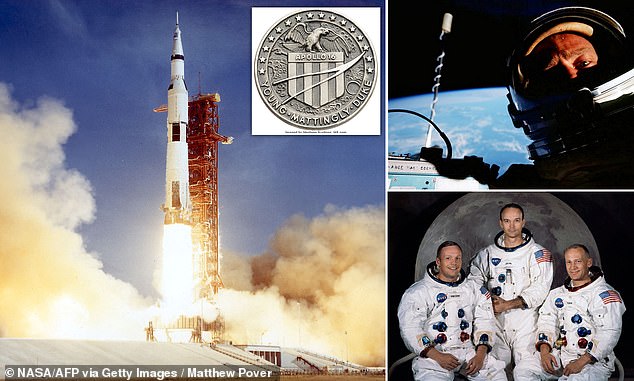Ask anyone over 60 to name a significant memory and many will say they remember watching the Apollo 11 moon landing on July 16, 1969 when NASA astronaut Neil Armstrong made history along with his fellow astronauts Buzz Aldrin and Michael Collins.
With the 55th anniversary of the landing this year, there is a great interest among collectors in space memorabilia from the Golden Age of Space (1950s-70s) who want their own piece of history. Think of equipment, photos and signatures.
While you might think that there are few real artifacts around in this niche market, this is not necessarily the case. Because in September 2012, the US government introduced a bill to give former NASA astronauts full ownership rights to the memories they collected during their missions.
NASA employees – all 400,000 of them at the time of the landing – were also able to purchase Apollo souvenirs after the program ended.
Adam Stackhouse, senior specialist in the history of science and technology at auctioneer Bonhams, says the anniversaries of the Apollo program and recent achievements in space exploration have all helped attract more collectors to the field, adding : ‘Prices have risen since we first held our Space History Auction in 2009.

Space souvenirs: Top right, Buzz Aldrin’s selfie on Gemini-12. Above right, a portrait of the Apollo 11 astronauts (from left) Neil Armstrong, Michael Collins and Buzz Aldrin. Inset: an Apollo 16 medallion
‘When searching for space memorabilia, provenance is crucial. Buyers must be able to trace the history of the item in question. For items produced in large quantities, such as NASA photographs, condition is an important factor and value will follow accordingly.”
Look for items used during the Apollo missions, especially Apollo 11, as they are always in high demand, says Stackhouse.
A fact sheet used by Apollo 11 pilot Buzz Aldrin in 1969 to land the lunar module ‘Eagle’ on the moon was sold by Bonhams last year for $44,800 (£35,468).
A star map used by Buzz Aldrin on the same mission fetched $38,400 (£30,355), while a signed copy of History Of Rocketry & Space Travel by rocket scientist Wernher Von Braun was snapped up for $10,240 (£8,097).
Next month, a collection of space photographs – including a signed photo of Apollo 7 astronaut Wally Schirra from 1962 – will be offered for sale at Bid Again Auctions to benefit the American Space Museum in Titusville, Florida.
More than 100 items, including a 1972 silver Apollo 16 medallion once owned by American physician and astronaut Story Musgrave, will go under the hammer on June 14 at Heritage Auctions in Dallas, Texas.
“Items flown can connect the collector to their respective mission like nothing else,” says Stackhouse. “Supply is limited because many of the important artifacts from the missions have been sent to the Smithsonian Museum.”
For anyone who wants to see space memorabilia instead of buying it at auction, the National Air and Space Museum in Washington DC is home to the world’s largest and most important collection of aviation and spacecraft artifacts.
However, rare items may appear at auction. In 2019, a gold medal worn by Neil Armstrong in his personal kit sold for $2 million (£1.6 million).
The medallion was part of a set made for astronauts at their request and had been in the Armstrong family for more than 50 years.
Two years earlier, a buyer paid $1.8 million for the bag Armstrong used to collect rock samples from the moon’s surface.
Florian Noller, a space dealer and founder of German retailer Been In Space, says: ‘We are currently seeing a lower supply of new items as most of the early astronauts have unfortunately disappeared and their collections have been sold.’
While new items may not come onto the market, it does increase competition among buyers, causing the value of items to skyrocket.
Noller added, “With the upcoming Artemis program next year, there will always be a historic demand for the first lunar flight and landings of Apollo 11 through 17.”
Original NASA photos are also valuable because they allow people to connect with the missions while conveying the emotions and achievements of the space program. Contemporary prints in good condition have become rare over the years because photographs can easily become damaged.
The first selfie taken in space, taken by Buzz Aldrin in 1966, sold for $19,125 (£15,113) in 2022.
Meanwhile, the first photograph of a human in space, taken in 1965 by Ed White’s James McDivitt during the first US spacewalk, was expected to fetch £6,000 at auction but went under the hammer at Christie’s in 2020 for £10,625.
Avoid items that have been mass-produced as they are unlikely to retain their value, advises Daniel Wade of Jersey-based auctioneer Paul Fraser Collectibles.
“There are tons of toys, souvenirs, costumes, books, models and so on that you can add to your collection,” he says. ‘A lot of this material is mass-produced and so probably won’t be hugely valuable.’
Instead, opt for personal items such as autographs.
‘The competition for quality signatures is fierce. Complete sets of signed period photographs of the Apollo 11 crew sell for an average of £15,000,” says Wade.
Armstrong reduced his signings over time and put down his pen in 1993, protesting the growing market for his autographs.
‘For single signers, Neil Armstrong is at the top of the market. A photo signed by Armstrong is worth an average of £10,000,” says Wade.
“My general advice to collectors is to buy what you like, and no matter where the market goes, you will always have something you like,” says Stackhouse.
Some links in this article may be affiliate links. If you click on it, we may earn a small commission. That helps us fund This Is Money and keep it free to use. We do not write articles to promote products. We do not allow a commercial relationship to compromise our editorial independence.

